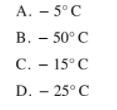
If the temperature of an object of 268K,it will be equivalent to:


Answer
567.9k+ views
Hint: The temperature is going to be measured with various units. Two among them are Celsius and Kelvin.
There is a relation between Celsius scale and Kelvin.
The relationship between Celsius and kelvin is as follows.
Temperature in Kelvin (K) = Temperature in $^{o}C$ + 273
Complete step-by-step answer:
- In the question they gave the temperature in Kelvin.
- Now we have to convert the given temperature to $^{o}C$ .
- The formula to convert the $^{o}C$ to Kelvin is as follows.
Temperature in $^{o}C$ = Temperature in Kelvin (K) – 273
Here $^{o}C$ = degree Celsius
K = Kelvin
(a) 268 K = Temperature in Kelvin
Temperature in $^{o}C$ = 268 K – 273 = -5 $^{o}C$
Therefore 268 K = -5 $^{o}C$
Clearly the answer is A.
Additional information:
- The simple difference between these Kelvin and Celsius scales is zero points (initial point) of the thermometer.
- Kelvin is the SI unit to measure temperature.
- There is one more unit to measure the temperature that is degree Fahrenheit heat (F).
- Numerically Kelvin value is higher when compared to degree Celsius scale.
-There is also another scale used. Fahrenheit is that scale.
-The formula to convert in between the Fahrenheit and celsius scale is:
$C=\dfrac{\left({ }^{\circ} \mathrm{F}-32\right) \times 5}{9}$
Thus
$32^{0} \mathrm{F}=0^{\circ} \mathrm{C}$
Note: The Kelvin scale is related to temperature. It is the thermodynamic scale based on an ideal heat engine that monitors the Carnot engine. One unit upsurge in the Kelvin scale is the same as one-degree upsurge in Celsius scale.
There is a relation between Celsius scale and Kelvin.
The relationship between Celsius and kelvin is as follows.
Temperature in Kelvin (K) = Temperature in $^{o}C$ + 273
Complete step-by-step answer:
- In the question they gave the temperature in Kelvin.
- Now we have to convert the given temperature to $^{o}C$ .
- The formula to convert the $^{o}C$ to Kelvin is as follows.
Temperature in $^{o}C$ = Temperature in Kelvin (K) – 273
Here $^{o}C$ = degree Celsius
K = Kelvin
(a) 268 K = Temperature in Kelvin
Temperature in $^{o}C$ = 268 K – 273 = -5 $^{o}C$
Therefore 268 K = -5 $^{o}C$
Clearly the answer is A.
Additional information:
- The simple difference between these Kelvin and Celsius scales is zero points (initial point) of the thermometer.
- Kelvin is the SI unit to measure temperature.
- There is one more unit to measure the temperature that is degree Fahrenheit heat (F).
- Numerically Kelvin value is higher when compared to degree Celsius scale.
-There is also another scale used. Fahrenheit is that scale.
-The formula to convert in between the Fahrenheit and celsius scale is:
$C=\dfrac{\left({ }^{\circ} \mathrm{F}-32\right) \times 5}{9}$
Thus
$32^{0} \mathrm{F}=0^{\circ} \mathrm{C}$
Note: The Kelvin scale is related to temperature. It is the thermodynamic scale based on an ideal heat engine that monitors the Carnot engine. One unit upsurge in the Kelvin scale is the same as one-degree upsurge in Celsius scale.
Recently Updated Pages
Master Class 11 Business Studies: Engaging Questions & Answers for Success

Master Class 11 Computer Science: Engaging Questions & Answers for Success

Master Class 11 Maths: Engaging Questions & Answers for Success

Master Class 11 Chemistry: Engaging Questions & Answers for Success

Master Class 11 Economics: Engaging Questions & Answers for Success

Master Class 11 Accountancy: Engaging Questions & Answers for Success

Trending doubts
What is meant by exothermic and endothermic reactions class 11 chemistry CBSE

10 examples of friction in our daily life

One Metric ton is equal to kg A 10000 B 1000 C 100 class 11 physics CBSE

1 Quintal is equal to a 110 kg b 10 kg c 100kg d 1000 class 11 physics CBSE

Difference Between Prokaryotic Cells and Eukaryotic Cells

What are Quantum numbers Explain the quantum number class 11 chemistry CBSE




